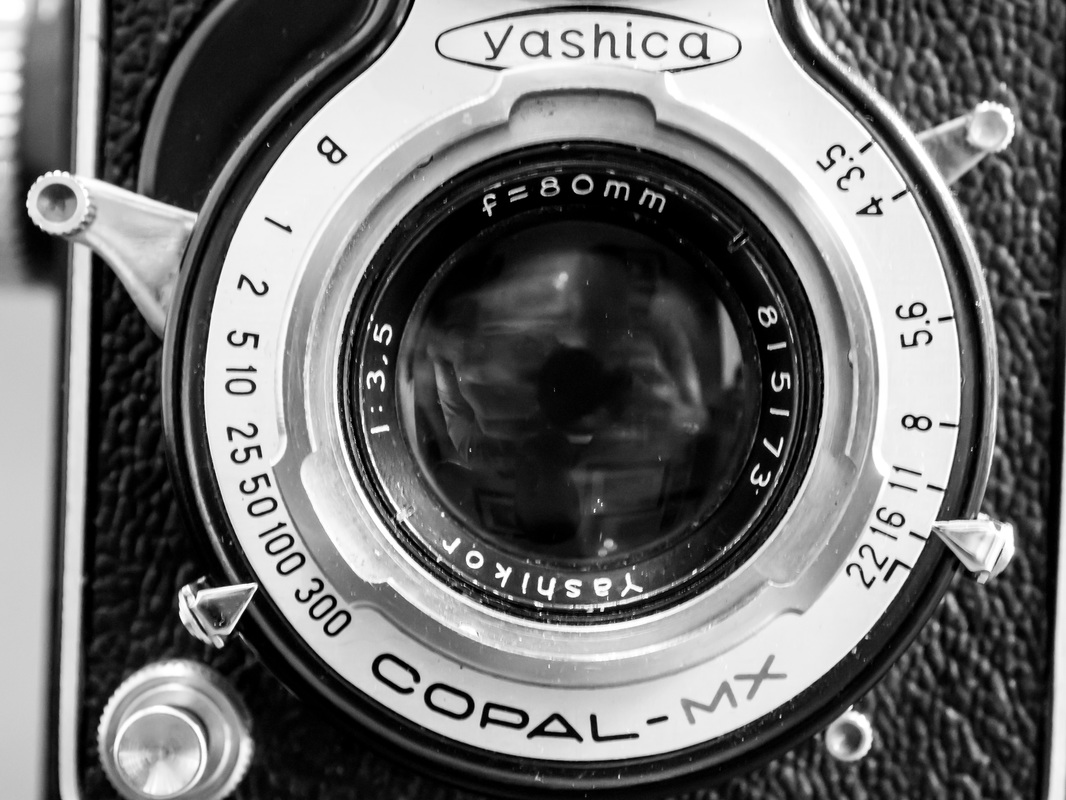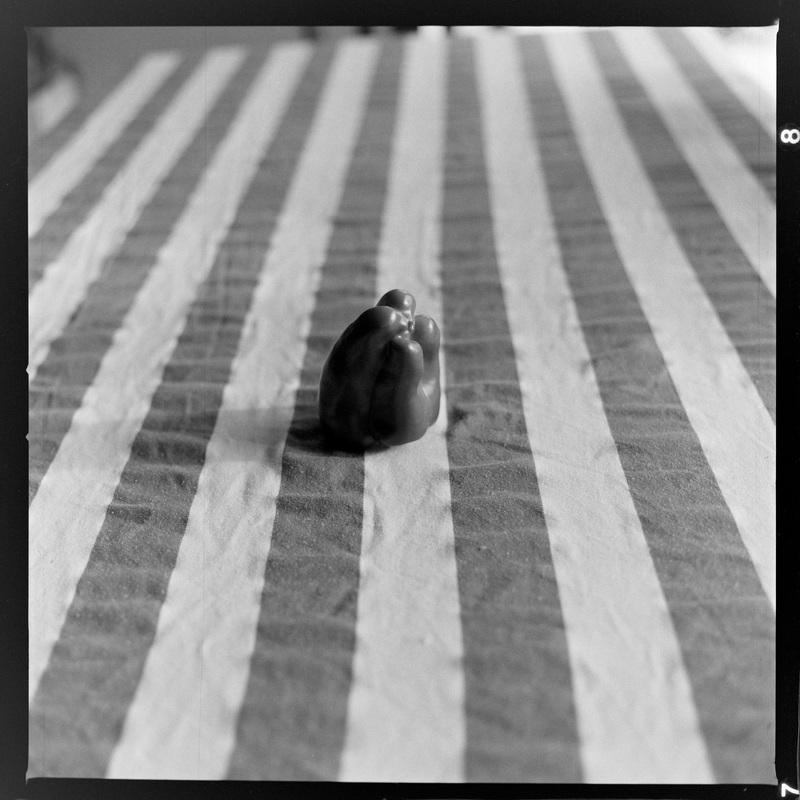|
The Yashica-C is a Twin Lens Reflex (TLR) camera where the focusing is done through one lens and the image is captured through the other. This style of camera was popular in the 1950's but soon lost its appeal in the late 1970's.
This one shoots 120 film in 6x6 cm negatives. You get 12 images per roll. The lens is an 80mm f/3.5 with a shutter speed of 1sec - 1/300 of a second and a bulb mode. With older cameras you should always look at the top speed as back through the 1960's film speed was relatively slow so a 1/300sec was more than enough. Consider the 1/1000 sec on some later film cameras or even the 1/2000 of a second on modern digital and you can see the potential pitfall. If you shoot fast film, ISO 400 for example and are out in a sunny day the sunny 16 rule would tell us that you need 1/400sec for a proper exposure however that is beyond this camera's capability. I do indeed shoot ISO 400 film through this camera but take it out on overcast days. Load in ISO 50 and the camera has plenty to offer. |
|
TLR cameras are great fun to shoot and the simple design makes them fairly solid performers even after all these years. The top of the line will set you back several hundred dollars (think Rolliflex) but the Yashica is a well built, cheaper alternative. The glass may not be of the quality of the Rolliflex but with a 6x6 negative the images will still impress.
As with all TLR the viewfinder is a "waste level" which means you view it from the top to compose the image. If you have never shot with one I HIGHLY recommend it. There is a three dimensional feel to the image that is impossible to describe. This view will make or break the TLR experience. The challenge is that the focusing screens originally put on many TLR (including the famed Rolliflex) dulls with age. Most people do not realize it and continue to work with the camera as is. When you see a properly functioning focusing screen your photographic world changes! It is bright, clear and almost appears as if you are seeing a picture from a projector. There is a challenge in that the movement through the viewfinder is reversed. So moving to the right moves the image to the left and vice versa. This always confuses me a bit so it takes me a few extra seconds to compose. Once you are used to it, it becomes second nature. |
|
I bought my Yashica-C and shot a few rolls through it. I decided to try a Custom Fitted Focusing Screen and after a bit of digging found Rick Oleson (see his web page HERE) who sold me a new focusing screen.
It is a bit intimidating to install however, following the instructions Rick sent over worked like a charm. After 10 minutes I had a glimpse of a focusing screen that worked like new. It is clear, evenly lit corner to corner and the 3D nature really jumps out at you. I purchased one with ⅓ focusing guidelines on it which helps me with composition and to ensure the scene is straight. This is important as being unfamiliar with how to hold such a camera getting straight shots is not as simple as it seems. I highly recommend Rick's focusing lenses and while mileage may vary depending on your camera, I find that these screens make focusing easier and more enjoyable. Go for the more expensive screens, they are worth every penny. |
|
The Good:
This is an economical way to get into TLR photography. All film enthusiasts should shoot with a TLR at some point. The Waist Level View Finder (WLF) gives you a unique perspective and it draws it fair share of attention. Once the focusing screen is changed out, the image through the WLF is AMAZING and worth the money. The controls are easy to use with a simple aperture and shutter speed selection on the bottom lens. The lens is a solid performer with apertures from 3.5 to 22. You cock the shutter on the lens itself and push the shutter release on the bottom left of the lens. |
The Bad:
There is no light meter on the camera. This means that you will have to use a dedicated light meter, or an App on your phone. In order to advance the film you must press a button to allow it to move. This makes it easy to forget if you already advanced the film or not. I keep making this mistake and while I am getting better it has resulted in double exposures or a wasted shot.
Overall:
Fantastic camera worth every cent. Get a new focusing screen and you will have a great deal of fun with the camera. It is smaller than many TLR which makes it easy to carry around. I usually do not use the straps it comes with as I pull it in and out of my camera bag. The images it makes are very good and while not of the quality of a Hasselblad it is available at 1/10th the price.
Price & Value:
If you want to get into medium format this is a good little camera to get. If you shoot medium format and are looking for a TLR, again this is a good price to get into. If you are looking to get into film photography this is not the camera for you. Simplify your life and get a more modern 35mm camera with a light meter. While I would love to get a Rolliflex the Yashica is serving me very well and scratching that TLR itch at a very respectable price. I bought mine for USD 150 and spent about USD 80 on a focusing screen.
Good Links:
Good overall technical information can be found HERE.
Manual of the Yashica-C can be found HERE. Please make a donation as this guy does us all a good service!
Yashica Camera porn (even with the odd music) HERE.
Yashica D camera intro (good but not a Yashica C model so slight differences) HERE.
Sample images below or you can look HERE.
There is no light meter on the camera. This means that you will have to use a dedicated light meter, or an App on your phone. In order to advance the film you must press a button to allow it to move. This makes it easy to forget if you already advanced the film or not. I keep making this mistake and while I am getting better it has resulted in double exposures or a wasted shot.
Overall:
Fantastic camera worth every cent. Get a new focusing screen and you will have a great deal of fun with the camera. It is smaller than many TLR which makes it easy to carry around. I usually do not use the straps it comes with as I pull it in and out of my camera bag. The images it makes are very good and while not of the quality of a Hasselblad it is available at 1/10th the price.
Price & Value:
If you want to get into medium format this is a good little camera to get. If you shoot medium format and are looking for a TLR, again this is a good price to get into. If you are looking to get into film photography this is not the camera for you. Simplify your life and get a more modern 35mm camera with a light meter. While I would love to get a Rolliflex the Yashica is serving me very well and scratching that TLR itch at a very respectable price. I bought mine for USD 150 and spent about USD 80 on a focusing screen.
Good Links:
Good overall technical information can be found HERE.
Manual of the Yashica-C can be found HERE. Please make a donation as this guy does us all a good service!
Yashica Camera porn (even with the odd music) HERE.
Yashica D camera intro (good but not a Yashica C model so slight differences) HERE.
Sample images below or you can look HERE.









